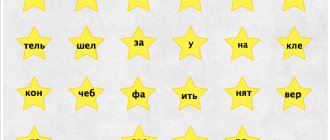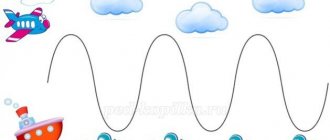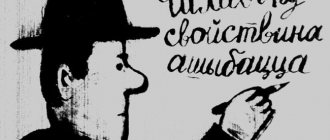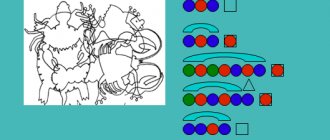Introduction
The problem of studying and correcting specific disorders of written speech in children (dysgraphia and dyslexia) is currently one of the most pressing tasks of speech therapy. Every year, the number of children with various types of dysgraphia in primary schools increases.
The agrammatic form of dysgraphia appears in children due to general speech underdevelopment (GSD). The immaturity of the grammatical, lexical and phonemic levels of a child’s speech is manifested in writing by a variety of specific errors that should not be mistaken for “misprints.” Such errors can lead to a decrease in the quality of not only writing, but also reading. In children, agrammatism is observed in oral speech and writing, which manifests itself in distortion of the morphological structure of the word, replacement of parts of the word (prefixes, inflections), violations in the composition of prepositional-case constructions, violations of agreement and inflection. With this form of dysgraphia, difficulties in constructing complex sentences, omissions of sentence parts, and violation of the sequence of words in a sentence are also noted.
Impaired writing in a child with agrammatic dysgraphia is persistent and systemic, so correctional work should be aimed at the speech system as a whole, and not just at eliminating an isolated defect. The formation of the morphological structure of the language (word formation and inflection skills) and sentence structure is carried out in parallel and in close connection with the development of the dictionary, phonemic analysis and synthesis.
A set of manuals designed to correct agrammatic dysgraphia in children is offered to specialists. It includes methodological recommendations, notes from frontal correctional classes and an individual workbook for the child to complete various tasks. The manuals represent practical material systematized by the author and are compiled taking into account methodological requirements.
Correction of agrammatic dysgraphia
Correctional work involves speech therapy principles of work. The main directions of correctional speech therapy: overcoming oral speech defects, development of language analysis and synthesis, word formation, development of spatial-analytical activity with the help of games for spatial orientation, improvement of the intellectual sphere, development of grapho-motor skills.
The formation of the grammatical side of speech is realized through a system of gradually more complex oral and then written exercises. Moreover, each task includes a sample of its implementation and a detailed oral explanation. By regularly completing assignments, students begin to understand language patterns and develop the skill of using grammatical forms correctly.
Correction of agrammatic dysgraphia includes:
Summary of an open lesson on correction of dysgraphia for 2nd grade students
Themes:
Speech therapy: development of phonemic analysis and synthesis of words of various sound-syllable structures.
Lexical: Winter .
Grammatical: the second way of indicating the softness of consonants in writing through a soft sign; separating b.
Goals:
1. Develop phonemic generalizations during exercises on sound analysis and synthesis of words; 2. To develop the ability to distinguish between hard and soft phonemes by ear; 3. Develop auditory memory and auditory perception; 4. Teach the designation of soft consonants in writing using b; 5. Instill the ability to navigate the lexical and grammatical features of a word; 6. Expand your vocabulary of adjectives and verbs on the topic “Winter”.
Equipment: pictures, didactic material.
Progress of the lesson.
I. Organizational moment.
The one who calls sits down:
- the last month of autumn, - the first month of winter, - the second month of winter, - the last month of winter, - what time of year comes after winter, - the first month of spring, - how many months does winter last.
II. Checking homework.
Each child asks one riddle. After solving each riddle, the corresponding picture is displayed on the board.
Puzzles:
• I twist, I growl, I don’t want to know anything. (Snowstorm)
• In summer it wanders without a path between pines and birches. And in winter he sleeps in a den, hiding his nose from the frost. (Bear)
• Who gets scared of everyone and hides under a bush? (Hare)
• So that the autumn would not get wet or become sour from the water, he turned puddles into glass and made the gardens snowy. (Freezing)
• There is a white nail hanging under our roof. The sun will rise, the nail will fall. (Icicle)
III. Isolating soft consonants from riddle words. Recording words - guesses with commenting and pronunciation.
- Name the word from the pictures in which the last consonant is soft. (Bear) Name the last sound in the word (TH) How do we write the word? (Bear) What letter should be written at the end of the word? (Soft sign) Why? (Because the last consonant is soft).
- Why is there after M-E in this word? (The word is written down in a notebook with pronunciation and commentary.)
- Name a word with a soft consonant in the middle of the word. (Icicle.)
- What is the soft consonant in this word? (LH). What is this sound? (5) What letter should be written after the letter L? Why?
- Find a word with a soft consonant at the beginning of the word. (Blizzard) What a soft sound? (Вь). Does Въ merge with subsequent sounds or is it separated in pronunciation: Вь-yuga? (Does not merge) What letter should be written after B? (b) What is this soft sign? (Divisive) Why? (B does not merge with Y)
Recording a word.
IV. Lesson topic message.
— Today we will continue to work on words in which b is written.
V. Development of sound-letter analysis and synthesis of words.
1. Development of phonemic synthesis. Guess the word based on the initial letters of the picture names:
Leaves (L) Tree (L) Turkey (I) Scissors (H) Pineapple (A)
This word: ICE
2. Development of phonemic analysis
a) Guessing the word.
- This word is part of the day; to learn this word, you must ask questions about the sounds and letters of the word.
Children ask questions: How many sounds are in a word? How many letters? Is the first consonant in this word hard or soft? (This is the word DAY)
b) Working with numbers.
Each student has a number row.
The speech therapist names the word and asks the following questions: How many sounds are in this word? How many letters? In what place should b be written? Why?
Suggested words: CEREAL, DAYS, HOUSING, DECEMBER.
c) Development of positional analysis.
There are pictures on the board: skates, trees, dove, spruce, calendar.
The speech therapist suggests naming the pictures:
- Take a picture whose name consists of one syllable (EL).
- What is the consonant sound at the end of the word? (L).
— How is it indicated in writing? (Letters L and L).
— Take a picture whose title contains the sound ВБ between the vowels E and I (TREES).
- What letter will you write before I? (b) What is this soft sign? (Divisive) What does it show? (That the consonant Вь does not merge with the vowel I).
- Take a picture in the title of which you hear Pb after A.
- What is the last letter you write at the end of the word? (b) Why?
- Take a picture in the title of which U is heard before Пь (Dove). What letters will you write at the end of this word? (B) Why?
VI. Working with phrases.
— What time of year do the words remind you of: blizzard, blizzard, icicles? (About winter) After what season does winter come? (After autumn) To what time of year does it give up its rights? (Spring)
— What soft consonants are heard at the end of the names of the winter months? (Рь, Рь, Л)
— In December there are already frosts, although not as severe as in January. How can you say differently instead of FROZE IN DECEMBER? (December frosts) In the word DECEMBER, after what letter do you write b? (After R). JANVARSKAYA – what are the soft consonant sounds? (There are none) Should I write b after P in the word JANVARSKAYA? (No, why ? (R-hard sound)
— In February it’s already getting warmer, sometimes there are even thaws; What do you call a THAW IN FEBRUARY? (February thaw) Is b written in the word FEBRUARY? After what letter? (L) Why?
Recording related words: DECEMBER-DECEMBER, JANUARY-JANUARY, FEBRUARY-FEBRUARY.
VII. Work with text.
— The famous Russian poet A. Blok wrote a very beautiful poem about winter. It is written on the board, but some of the words in it are encrypted. We need to guess them, and then we will be able to read this poem expressively.
There is a poem on the board, some words are missing letters.
Snow and snow patterns, In the field at (5-2), conversations, At (4-4) o’clock already t (4-2). D (4-4) - k (6-4), snowballs, sleds: Here it is winter.
The speech therapist explains the encryption of words: the first number means how many letters are in the word, and the second – where b is written (words: BLIZZARD, FIVE, DARKNESS, DAY, SKATES)
Children go to the board and write words in the text. And then they expressively read the written poem.
VII. Summing up the lesson.
Sorokataya Olesya Fedorovna, teacher - speech therapist, secondary school No. 13, Neryungri RS (Yakutia)
- Summary of an open speech therapy lesson in the senior group “How Pinocchio looked for friends”
- Summary of an open speech therapy lesson in the senior group “The Magic Letter M”
- Summary of a literacy lesson for children in the preparatory school group “Sound and letter Y”
- Summary of a speech therapy lesson for grade 3 on the topic “Suffixes in the names of professions -nik-, -chik-, -schik-, -el-, -ist-”
- Summary of frontal speech therapy lesson “Softening and dividing soft sign”
( 4 liked, average score: 5.00 out of 5)
Loading...




